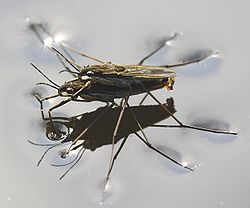- Neuston
-
Neuston is the collective term for the organisms that float on the top of water (epineuston) or live right under the surface (hyponeuston). Neustons are made up of some species of fish (see flying fish[1]), beetles (see whirligig beetle), protozoans, bacteria and spiders (see fishing spider and diving bell spider). A water strider is a common example that skips across water's surface tension.
Contents
Other uses of the word
By extension, the term may also refer to non-organismal floating aggregations (see, e.g., Great Pacific Garbage Patch).
Contrasts with other aquatic life
Contrast the terms plankton (the organisms that float or drift within the water), nekton (the organisms that swim (powerfully) in the water), and benthos (the organisms on the bottom of a body of water).
Neuston is sometimes refers to only that subset of floating organisms that are microscopic[2] or those that rely on surface tension to float.[3] The term pleuston refers to superset including those organisms that float by bouyancy or are macroscopic.
Etymology
The term neuston is rooted in the Greek adjective νευστός neustós ("the swimming") derived from the verb νεύειν neúein ("to incline").
References
- ^ The Sea Surface and Global Change by P. S. Liss, Robert A. Duce
- ^ P. S. Liss, W. George N. Slinn. Air-sea exchange of gases and particles. pp. 148. ISBN 90-277-1610-2.
- ^ James H. Thorp, Alan P. Covich. Ecology and classification of North American freshwater invertebrates. pp. 34. ISBN 0-12-690647-5.
External links
- "neuston - Britannica Online". Encyclopedia Britannica. http://www.britannica.com/eb/article-9055398/neuston. Retrieved 2007-11-13.
- "Dictionary entries for 'neuston'". Ask.com. http://www.ask.com/reference/dictionary/ahdict/26494/neuston. Retrieved 2007-11-13.
Categories:- Aquatic ecology
- Ecological definitions
- Biogeography
- Ecology
- Habitats
Wikimedia Foundation. 2010.




